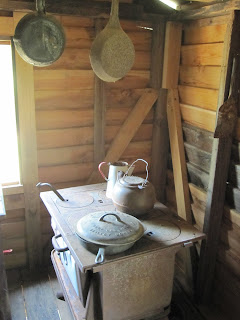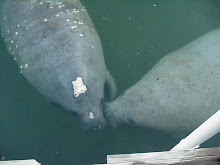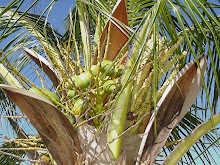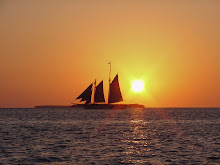
Wednesday, June 30, 2010
Tuesday, June 29, 2010
St. Augustine Adventure: Day Three or Mainly Research
 Day three started out like day two...breakfast from McDonald's, taken to the Mission Nombre De Dios cemetery grounds to eat, except that we were prepared for the onslaught of hungry squirrels. We had purchased a bag of peanuts the night before.
Day three started out like day two...breakfast from McDonald's, taken to the Mission Nombre De Dios cemetery grounds to eat, except that we were prepared for the onslaught of hungry squirrels. We had purchased a bag of peanuts the night before.

 After breakfast we visited another cemetery across town to discover where Joseph Blanchard's first wife was buried. She was the mother of little Arthur whose grave we found earlier in the mission's cemetery. She was not buried with Arthur because she remarried, died years later and is buried next to her husband.
After breakfast we visited another cemetery across town to discover where Joseph Blanchard's first wife was buried. She was the mother of little Arthur whose grave we found earlier in the mission's cemetery. She was not buried with Arthur because she remarried, died years later and is buried next to her husband.We spent the biggest part of the day pouring through historical documents at the local historical library and learning more about the Blanchard family. The Colonel was in his element. He is the historian for the Blanchard House Museum and enjoyed himself while digging through the old papers. I enjoyed it too.
Monday, June 28, 2010
St. Augustine Adventure: Day Two or A Few Forts
We all boarded a pontoon boat. A park ranger gave us a brief history of the fort as he piloted the boat across the Matanzas River. It was a clear, sunny morning and seeing the fort across the water was quite a sight to see.
Fort Matanzas was constructed in 1740-42 as Spain's last effort to ward off British attacks and encroachments on St. Augustine.
The town had one weakness: Matanzas Inlet, 14 miles south, allowed access to the Matanzas River, by which enemy vessels could attack St. Augustine from the rear.
The trip across the river was short and soon the ranger (along with the help of ranger #2) docked the boat near the fort.

The Colonel and I were the first ones out of the boat and onto dry land (being younger and more nimble than the other tourist couple).
We tourists were given free range of the fort. The Colonel and I climbed over every inch of the fort. We climbed stairs into the fort and first saw the cannons on its gun deck.
 Then into the Soldiers' Quarters on the same level as the gun deck.
Then into the Soldiers' Quarters on the same level as the gun deck.

Soldiers were rotated from St. Augustine for one-month duty tours at Matanzas, usually an officer-in-charge, four infantrymen, and two gunners. More could be assigned to this remote outpost when there was an enemy threat, up to 50 more during a crisis.
We climbed more stairs up to the Officer's Quarters, a vaulted room directly above the Soldiers' Quarters.


 Climbing up the ladder, there was not much room to spare (remember the Spanish were a lot smaller than we are today), but The Colonel and I made it to the Observation Deck. The older couple did not attempt the climb, so The Colonel and I had the deck to ourselves.
Climbing up the ladder, there was not much room to spare (remember the Spanish were a lot smaller than we are today), but The Colonel and I made it to the Observation Deck. The older couple did not attempt the climb, so The Colonel and I had the deck to ourselves.

 We toured the fort for about half an hour.
We toured the fort for about half an hour. The boat ride back across the river was as pleasant as the one to the fort. When the boat docked we saw a large crowd of adults and children waiting for the next tour. The Colonel and I both were glad we took the early tour. I am sure the older couple were thinking the same thing.
The boat ride back across the river was as pleasant as the one to the fort. When the boat docked we saw a large crowd of adults and children waiting for the next tour. The Colonel and I both were glad we took the early tour. I am sure the older couple were thinking the same thing.Our next stop was to Fort Mose (pronounced moe-say) Historic State Park.
 This is an artist's drawing of what Fort Mose number two would have looked like.
This is an artist's drawing of what Fort Mose number two would have looked like. By the late 1600s, black slaves had learned that they could escape their British masters in the Carolina Colony and seek freedom and asylum in Spanish Florida if they embraced Catholicism and pledged to serve the Spanish Crown. In 1738 the Florida Governor granted these blacks a plot of land about two miles north of St. Augustine where they could build their own community and fort. The community housed 38 men and their families. It was estimated that about 100 people lived there. They adopted Spanish names and Spanish culture with an African flavor.
By the late 1600s, black slaves had learned that they could escape their British masters in the Carolina Colony and seek freedom and asylum in Spanish Florida if they embraced Catholicism and pledged to serve the Spanish Crown. In 1738 the Florida Governor granted these blacks a plot of land about two miles north of St. Augustine where they could build their own community and fort. The community housed 38 men and their families. It was estimated that about 100 people lived there. They adopted Spanish names and Spanish culture with an African flavor.This was the beginning of Fort Mose, North America's first free legally sanctioned Black community.
In 1740 British soldiers from the newly colonized Georgia marched toward Fort Mose, its inhabitants were safely evacuating to St. Augustine. The British troops set up camp at the abandoned Fort Mose. The next month 300 Spanish soldiers, including the black militia, staged a surprise attack on the British. They recaptured the fort, leaving 68 British dead and taking 34 prisoners. The remaining British soldiers retreated to Georgia.
With the original fort demolished, African settlers lived in St. Augustine until 1752 when a new fort and town were rebuilt.
In 1763, Florida was ceded to Britain and those living at Fort Mose evacuated along with other Spanish citizens to the northwest coast of Cuba.
The last fort we visited was the Castillo de San Marcos, St. Augustine's main fort. We did not take an inside tour (we did that in 2003), I only wanted to walk around the fort and take pictures.
 The building of the Castillo began in 1672 and it took 23 years to complete. Originally the fort was covered with white plaster and the towers in the four corners were plastered in red.
The building of the Castillo began in 1672 and it took 23 years to complete. Originally the fort was covered with white plaster and the towers in the four corners were plastered in red.The British attacked the fort in 1702 and 1740, but both times the Spanish were able to defend themselves from within the fort. It is an impressive fortress. I will let the pictures speak for themselves.





 In addition to visiting the forts on day two, The Colonel and I took a tour of the local winery, lunched at Columbia Restaurant, walked other cemeteries (more buried Blanchard family members), drove through Lincolnville (a historic black community of St. Augustine where Dr. Martin Luther King stayed while there, we drove by the houses) and we also saw an exact replica of the statue of David on the grounds of the Ripley's Believe It or Not Museum.
In addition to visiting the forts on day two, The Colonel and I took a tour of the local winery, lunched at Columbia Restaurant, walked other cemeteries (more buried Blanchard family members), drove through Lincolnville (a historic black community of St. Augustine where Dr. Martin Luther King stayed while there, we drove by the houses) and we also saw an exact replica of the statue of David on the grounds of the Ripley's Believe It or Not Museum.

Sunday, June 27, 2010
St. Augustine Adventure: Day One or Should I say Evening?

With Spud situated, The Colonel and I drove the beautiful, coast road up to St. Augustine. We arrived later than scheduled, so did not have enough time to do much but check into our hotel room and walk around The Oldest City for a little while before it was time to turn in for the night.
On our walk we visited the Mission of Nombre De Dios (Name of God) and the cemetery there. It is a very beautiful place. A path winds through the little cemetery that is shaded by many trees. In the middle of the cemetery is a chapel that houses a shrine to Nuestra Senora De La Leche y Buen Parto (Our Lady of the Milk and Happy Delivery).
The first shrine was built in the early 1600's when the Spanish established the mission. The original and several reconstructions were damaged by storms and attacks (Indians and British). It was rebuilt in 1875 by the first bishop of the Diocese of St. Augustine, Augustin Verot, but it too was destroyed by a major hurricane. The present chapel was reconstructed in 1915 and enshrines a replica of the original Our Lady statue.

 On September 8, 1565, Pedro Menendez de Aviles landed and founded St. Augustine at the site that would later become the Mission of Nombre De Dios. St. Augustine is the first permanent Christian settlement in the United States and the first mass in the U.S. was offered here. It is commemorated by a statue of the priest who offered the mass, Padre Francisco Lopez de Mendoza Grajales and a 208 foot, Great Cross.
On September 8, 1565, Pedro Menendez de Aviles landed and founded St. Augustine at the site that would later become the Mission of Nombre De Dios. St. Augustine is the first permanent Christian settlement in the United States and the first mass in the U.S. was offered here. It is commemorated by a statue of the priest who offered the mass, Padre Francisco Lopez de Mendoza Grajales and a 208 foot, Great Cross.

 The sun was going down and it was time to go back to our hotel room. Day two of our St. Augustine Adventure was going to be dedicated to sightseeing as the research libraries would not be open until the following day. Big day ahead.
The sun was going down and it was time to go back to our hotel room. Day two of our St. Augustine Adventure was going to be dedicated to sightseeing as the research libraries would not be open until the following day. Big day ahead.Wednesday, June 23, 2010
Wednesday, June 16, 2010
Saturday, June 12, 2010
St. Augustine Adventure
The Colonel and I will be in St. Augustine, FL. We will be doing research for The Blanchard House Museum (and some sightseeing too!).
Stay tuned...
Thursday, June 10, 2010
Happy Birthday Spud!

 Here are some of our favorite pictures taken of Spud throughout these swiftly passing years.
Here are some of our favorite pictures taken of Spud throughout these swiftly passing years. 





Happy 17th Birthday Spud!
Wednesday, June 9, 2010
Sunday, June 6, 2010
Tallahassee Day Five

 The Colonel noticed that our network director was holding her hands in an unusual way behind her back...she had her thumbs tucked inside her fists.
The Colonel noticed that our network director was holding her hands in an unusual way behind her back...she had her thumbs tucked inside her fists. We asked her why she was doing that. "Out of habit", she said. Why would a habit like that start we asked. "When I was a little girl, I was told never to point in a graveyard or your fingers would rot off, so I hold onto my thumbs with my fingers so as not to point," she said. The Colonel and I had never heard of this practice. I am sure the next time I am in a graveyard I will remember this.
We asked her why she was doing that. "Out of habit", she said. Why would a habit like that start we asked. "When I was a little girl, I was told never to point in a graveyard or your fingers would rot off, so I hold onto my thumbs with my fingers so as not to point," she said. The Colonel and I had never heard of this practice. I am sure the next time I am in a graveyard I will remember this.


 The white planters allowed their slaves to join the church and attend services with them, but the slaves had to sit up in the balcony.
The white planters allowed their slaves to join the church and attend services with them, but the slaves had to sit up in the balcony.We visited the graveyard of the church. The oldest burial there was dated 1817 (J D Hodges).

 Our final stop for day five and our Tallahassee trip was to Tall Timbers Research Station and Land Conservancy. It is known world wide for its fire ecology and game bird management. Tall Timbers is on more than 100,000 acres, some of which reach into south Georgia.
Our final stop for day five and our Tallahassee trip was to Tall Timbers Research Station and Land Conservancy. It is known world wide for its fire ecology and game bird management. Tall Timbers is on more than 100,000 acres, some of which reach into south Georgia.Henry Beadel once owned this land and built a house (1896) on it to use as a quail hunting plantation. He had no heirs, so he left the house and all the land to the research station.
 This is the view from the front porch. In the distance you can see Lake Iamonia.
This is the view from the front porch. In the distance you can see Lake Iamonia. Mr. Beadel had the Jones family, who were black tenant farmers, living on the property; they helped with the management of the quail hunting plantation. We rode a wagon pulled by a truck through the wooded areas to see the tenant farm buildings that have been refurbished and made into a history park of sorts.
Mr. Beadel had the Jones family, who were black tenant farmers, living on the property; they helped with the management of the quail hunting plantation. We rode a wagon pulled by a truck through the wooded areas to see the tenant farm buildings that have been refurbished and made into a history park of sorts.



 It was soon time to get back on the wagon (no pun intended) and head back to the research center building for a Bar-B-Que lunch catered by Sonny's. Deeelicious.
It was soon time to get back on the wagon (no pun intended) and head back to the research center building for a Bar-B-Que lunch catered by Sonny's. Deeelicious.After lunch The Colonel and I took a tour of the Beadel House!

 It was time to get back on the trolley to head back to Tallahassee and the hotel, our trip was winding up. The trolley's transmission had other ideas. The Colonel, two other network members and I were able to get a ride back with one of the Tall Timber workers.
It was time to get back on the trolley to head back to Tallahassee and the hotel, our trip was winding up. The trolley's transmission had other ideas. The Colonel, two other network members and I were able to get a ride back with one of the Tall Timber workers. Even with the little hiccup at the very end of our Tallahassee trip, The Colonel and I thoroughly enjoyed it and wouldn't mind going back there one day, but next time take it a bit slower and see more of what Tallahassee has to offer.
Even with the little hiccup at the very end of our Tallahassee trip, The Colonel and I thoroughly enjoyed it and wouldn't mind going back there one day, but next time take it a bit slower and see more of what Tallahassee has to offer.







































